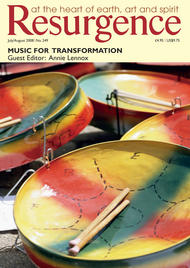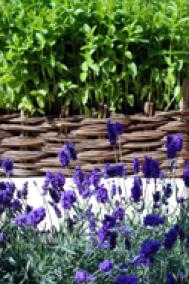“THE CHELSEA FLOWER show is going green” – so proclaimed the headlines on the newsstands near the Royal Hospital grounds in London. Exhibitors are being encouraged to place excess materials, plants and organic waste in the new Recycling Yard, where they will be donated to local community gardens. Plastic bags are being replaced with cornstarch bags, and patio heaters, fossil stones and petrified wood products are banned. An information-gathering process is also being undertaken by the Royal Horticultural Society (RHS) to determine how exhibitors source their timber, plants and materials and whether they make the effort to use peat-free compost and FSC-certified wood, with a view to ensuring that future designers and exhibitors are encouraged to account for these processes in their show gardens.
But the fact remains that the fossil-carbon footprint of an event dedicated to what should be the most sustainable practice of all is huge. One look at this year’s Chelsea Flower Show provides confirmation that this fossil-fuel-intensive trend in gardening is set to continue, with massive olive and lemon trees being shipped-in from Southern Europe for a chilly fate on the patios of England, South African protea being touted as the gardening solution to climate change, despite the fact we cannot eat them, and most worrying of all, the National Farmers Union stand being dedicated to a totally industrial vision of the future of food production. Like the London Fashion Week, Chelsea Flower Show is mostly concerned with this year’s hottest brand or trend, albeit of the horticultural variety. This is the gardening equivalent of the Oscars – it sets precedents and makes fortunes.
How is it that one of the most intimate relationships we have with Nature – that of gardening – has become so fossil-fuel intensive, so unsustainable, so preoccupied with design and control? Gandhi believed that gardening is a spiritual discipline, and to thousands of people who commune with Nature and respect her cycles and seasons, it is. Yet any weekend visit to a garden centre will confirm that it is also big business and mostly very far removed from the concept of sustainability.
Even gardeners with a commitment to the organic and sustainable ethos must look in the garden shed with dismay, to see the ubiquitous piles of plastic compost bags awaiting their fate, the myriad plastic plant pots of all shapes and sizes stacked like toppling tombstones. Why do we buy-in to this concept of gardening? Where could we get our compost and plants if not from the garden centre and multinational corporations?
If we are going to address climate change then our attitude to gardening is a good place to start. The way we feed ourselves (or allow ourselves to be fed – via multinational corporations with all the embedded fossil-fuel that necessitates) accounts for about one-fifth of the greenhouse-gas emissions we are each responsible for. Therefore, to produce some of our own food by gardening, taking advantage of that blessing of renewable carbon, instead of fossil carbon, allows us to truly address our carbon footprint. Sadly, at Chelsea this year, only one or two of the gardens had any vegetables in them at all.
GARDENING HASN’T QUITE lost its way – there is a growing trend towards bringing gardening back to its basics. The passion for ‘allotmenting’ is proof positive that gardening is going back to its roots – the locality and the community. If all villages had a recycling centre next to the allotments where community organic waste could be turned into compost en masse and collected for free, where plant pots and tools could be shared and exchanged and where plants and seeds could be swapped and given away, how much richer our gardening experience would be – and not just financially. We would have come full-circle, back to the gardening of our forebears, when fossil-fuels were not available and recycling was the natural way to re-use our waste products.
At this year’s Chelsea Flower Show, the Daylesford Organic Summer Solstice Garden aimed to educate the public on these natural gardening principles. It certainly stood out from the crowd, with its wheat meadow laced with wild flowers, its ‘Midland bullock-hedge’ flanked by a wildlife-friendly ditch edged with yellow iris, lady’s smock and other wetland natives, and its woven-willow compost bins and wormery. It was a real, living garden in every sense, exuding a healthful vitality that was tangible. Indeed, one nearby garden seemed so sterile, so over-designed in comparison that it had all the charm of the upper-deck of a cross-channel ferry!
Perhaps the inherent natural beauty of the Summer Solstice Garden was due to the fact that it wasn’t ‘designed’, as Carole Bamford, owner of Daylesford Organic and the ‘visionary’ behind the garden explained: “The wheat meadow is just as it is on our farm: full of corn chamomile, cornflowers, ragged robin and poppies – flowers that attract beneficial insects and maintain the balance of the ecosystem.” Instead of the obligatory, lifeless water-feature, the ditch that edged the wheat meadow had already been colonised by insects, flora and fauna. The pollarded willow on its banks filters the water and provides incredible biomass in the form of willow whips, that each year can be harvested for woodchips, repairing the raised-bed wattle hurdles, or strengthening the fence. Even the meadowsweet, that heady-perfumed mother of all the astilbes that graced the rest of the show, can be harvested to make a refreshing summer drink, or sweet-smelling hay bedding for the children’s pets or the hens.
Indeed all the planting for the Summer Solstice Organic Garden is edible or useful in some way, with many wild species including water mint, red clover, valerian, cob nut, hawthorn, elder, wild strawberries, herb Robert, self- heal, meadow clary, wild thyme and many more. The integrity of this garden was recognised by Patrick Holden, Director of the Soil Association, who said, “Daylesford Organic has pushed the boundaries of what can be achieved in a garden and it is a wonderful demonstration of organic principles.”
Bakers and chefs in its grass-roofed and solar-panelled summerhouse (which, together with the whole garden, will be taken back to the farm and used for schoolchildren to visit and learn about the cycles of gardening and cooking) invited the public to taste the produce grown in the garden. Admittedly, the flour for the bread was sourced from last year’s crop on Daylesford organic farm – but it is only a matter of time before the garden’s own wheat meadow could be harvested, threshed and milled.
Carole Bamford’s vision for this garden was to educate and inspire visitors to replicate some of the techniques in their own gardens. In my own courtyard garden, there is no room for a willow tree, but I can remove four paving slabs, weave a low wattle hurdle edging, fill it full of soil and compost and grow beets, climbing beans and lemon verbena, and together with my allotment it will become my twenty-first-century, post-peak-oil supermarket. I’m sure the Daylesford Summer Solstice Organic Garden inspired thousands of others too, and in so doing, in a most practical way, helps to reduce our fossil-carbon footprint.
As sustainable principles filter through to trendsetting Chelsea Flower Show there is hope that many of the gardens of Great Britain will begin to incorporate organic and natural gardening techniques. There is also talk that as planning and environmental issues impact on the Chelsea Flower Show, the RHS is considering decentralising the show to six regional areas of the UK, which can only be a good thing. Let us hope that many more sustainable gardens will be showcased, to give people an insight into the spiritual discipline that is gardening.
Lorna Howarth is Co-editor of Resurgence.








